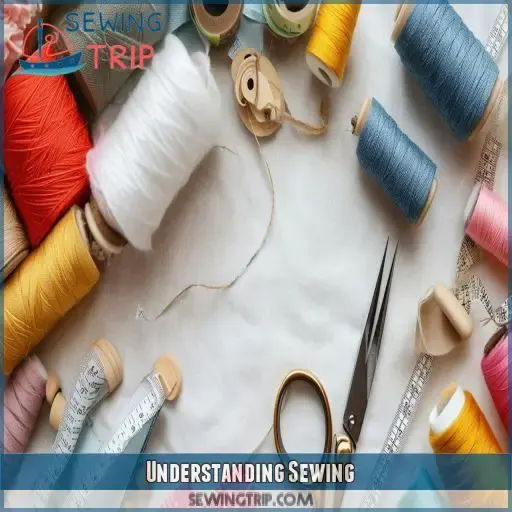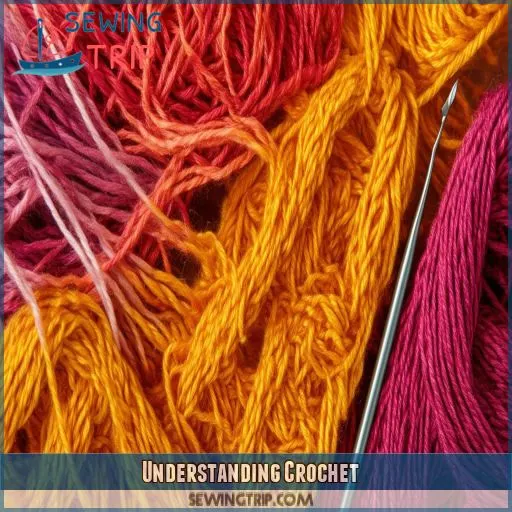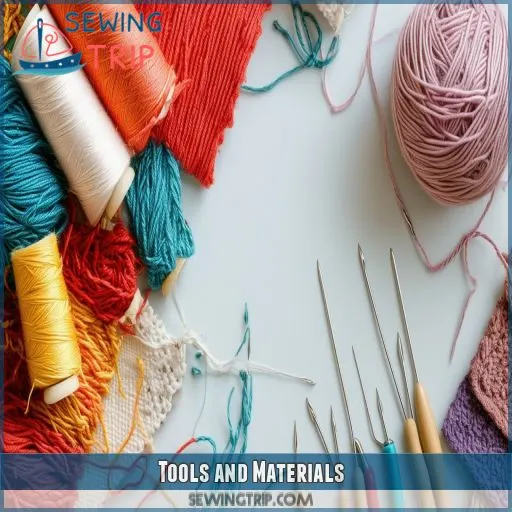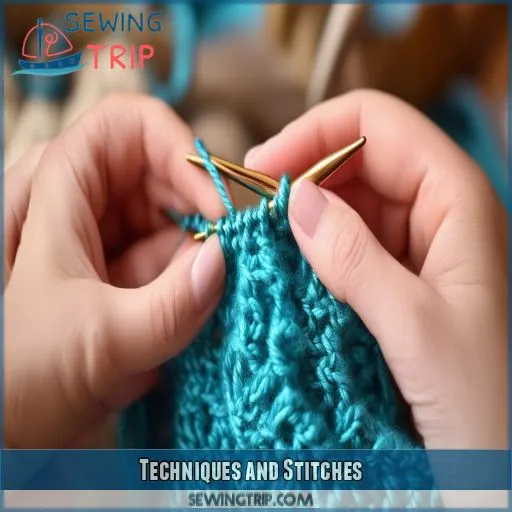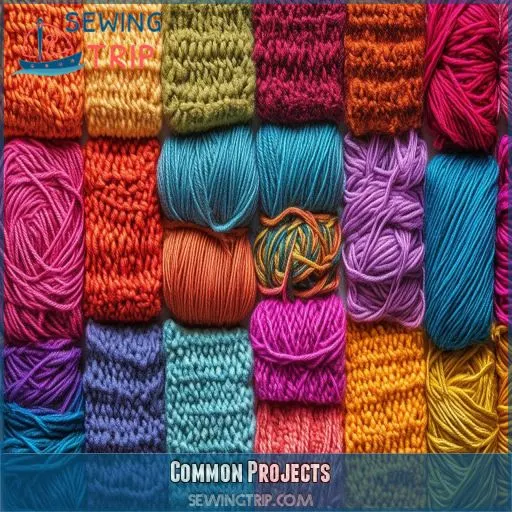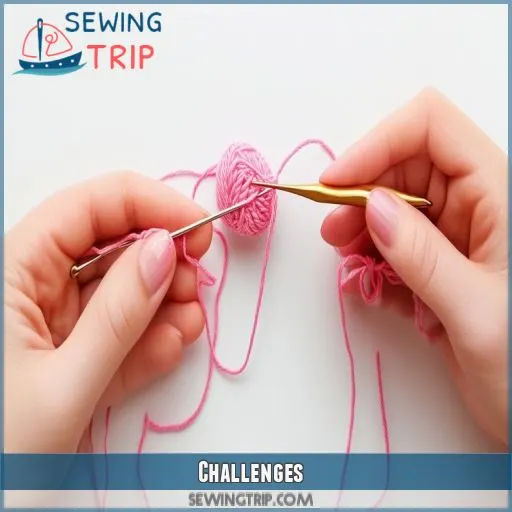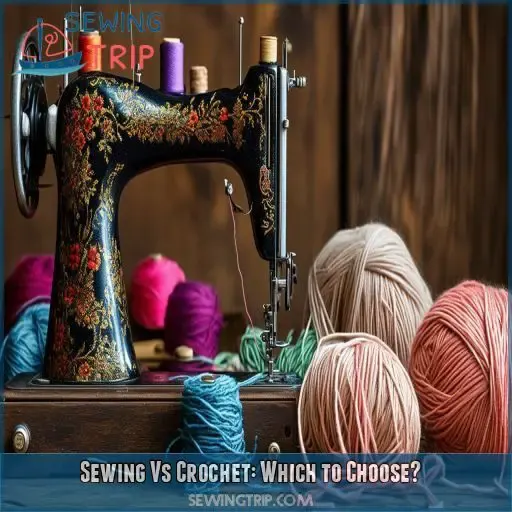This site is supported by our readers. We may earn a commission, at no cost to you, if you purchase through links.
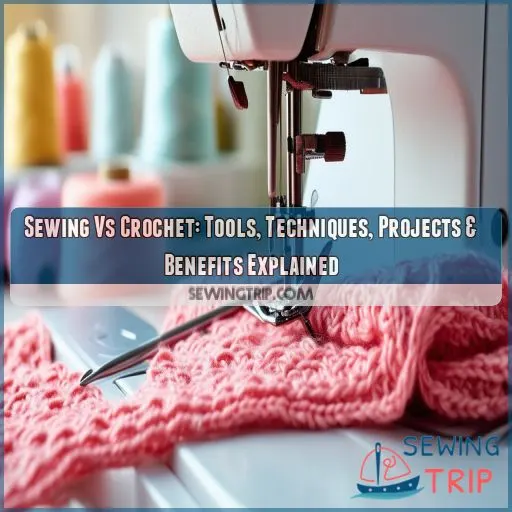
Both crafts offer a wide range of project possibilities, from garments to home decor. Sewing excels in precise, structured projects, while crochet shines in creating textured, flexible items.
Your choice depends on your project goals, preferred tools, and desired learning curve. Whether you’re stitching straight seams or hooking intricate patterns, both crafts offer rewarding creative outlets.
Let’s unravel the details of each craft.
Table Of Contents
Key Takeaways
- Sewing and crochet are like apples and oranges – both delicious fruits, but with distinct flavors. Sewing’s all about joining fabrics with precision, while crochet weaves its magic one loopy stitch at a time.
- Tools of the trade? Sewing’s got more gadgets than Inspector Gadget – machines, needles, and enough thread to lasso the moon. Crochet keeps it simple with a hook and yarn, perfect for crafting on the go or while binge-watching your favorite show.
- When it comes to project variety, both crafts are overachievers. Sewing’s your go-to for everything from patching up your favorite jeans to whipping up a red-carpet-worthy gown. Crochet, on the other hand, shines in creating cozy blankets, quirky toys, and accessories that’ll make your grandma proud.
- Learning curves can be as unpredictable as a rollercoaster, but fear not! Sewing might seem easier to start, but crochet’s got a "one stitch at a time" approach that’ll have you hooked in no time. Whichever path you choose, remember: Rome wasn’t built in a day, and neither was that perfect sweater.
Understanding Sewing
Sewing has a rich history, evolving from hand-stitched garments to modern machine techniques.
You’ll work with various fabric types, each requiring specific needle sizes and thread weights for satisfactory results.
Selecting the right pattern is key; it determines your project’s design and complexity.
Essential tools include needles, fabric, thread, and sewing machines.
Mastering fundamental stitches like straight and zigzag opens creative avenues, from making clothes to home décor.
Sewing offers endless customization and practical skills.
Understanding Crochet
Crocheting is a versatile craft where you use a hook to create fabric from yarn. Unlike knitting, crocheting uses one active loop at a time.
You can make a variety of projects, from granny squares to intricate amigurumi toys.
Understanding stitch variations, such as single crochet and double crochet, is essential. Different yarn types can affect the texture and appearance of your projects.
Mastering crochet techniques grants endless creative possibilities, empowering you to craft unique and functional items.
Tools and Materials
When considering sewing and crochet, you need different tools and materials for each craft. We’ll compare the essential items required for both, highlighting their unique purposes and functionalities.
Sewing Tools
When getting into sewing, having the right tools and materials is essential. You’ll need:
- Sewing Machine: Necessary for efficient, precise stitching.
- Needles: Different sizes for various fabric types.
- Thread: Various weights to match fabric strength and flexibility.
- Fabric: Choose from cotton, silk, polyester, and more.
- Seam Ripper: Helps correct mistakes quickly.
These tools help transform your creativity into tangible projects. A sturdy sewing machine guarantees reliable stitches, while selecting the right needle sizes and thread weights improves your outcomes. Experiment with different fabric types, and always account for seam allowances in your designs.
Crochet Tools
Now, let’s explore crochet tools. You’ll primarily need a crochet hook and yarn. Crochet hook sizes vary, and selecting the correct size is essential for upholding your crochet gauge.
Yarn or crochet thread is available in various weights and fibers, influencing the final product’s appearance and texture. Furthermore, stitch markers are useful for tracking your position in intricate crochet stitch patterns.
A measuring tape and row counter can be helpful for larger projects. These necessities make your crocheting journey efficient and pleasurable, enabling your creativity to blossom seamlessly.
Techniques and Stitches
Sewing techniques include various stitches like straight, zigzag, and hemming, each serving a specific purpose in fabric manipulation. In crochet, stitches such as single crochet, double crochet, and slip stitch are used to create intricate patterns and textures with yarn.
Sewing Techniques
Now that you’ve acquired the requisite tools and materials, it’s time to embark upon sewing techniques.
Mastering diverse stitches and techniques will elevate your sewing game. Commence with the fundamentals such as straight stitch, zigzag stitch, and hemming stitch.
Subsequently, progress to more advanced techniques like fabric bonding, pattern drafting, and seam finishing.
Remember machine maintenance and thread selection to ensure your projects turn out flawlessly.
With these skills, you’ll be creating stunning garments, accessories, and home decor items in no time.
Crochet Techniques
When you engage in crochet, you’ll encounter a variety of techniques. Basic stitches like single crochet, double crochet, and slip stitch form the foundation.
The yarn weight and hook size directly impact the stitch gauge, affecting your project’s look and feel. Different yarn fibers add another layer of customization.
Crochet offers versatility, from simple designs to intricate lacework. While it might seem less complex than knitting, maintaining consistent tension can be challenging.
On the bright side, crochet projects usually work up faster, making it a satisfying and efficient crafting choice.
Common Projects
Concerning common projects, sewing and crochet provide an extensive array of options. In sewing, you’ll engage in crafting garments, accessories, and home decor, whereas crochet endeavors often encompass toys, blankets, and elaborate accessories.
Sewing Projects
When diving into sewing projects, you’ll quickly discover a range of creative opportunities. Popular undertakings often include:
- Garments: Craft unique clothes, where fabric selection, pattern drafting, and thread types play critical roles.
- Accessories: Design bags, hats, or belts, leveraging both sewing machines and hand embroidery for distinctive touches.
- Home Decor: Create curtains, pillow covers, or tablecloths, perfect for sprucing up your space.
- Repairs and Alterations: Update or mend existing clothes, utilizing techniques like hemming and patchwork.
These projects offer a blend of practicality and creativity, letting you master sewing skills while producing functional items.
Crochet Projects
Creating crochet projects unlocks a realm of imagination and contentment. Craft adorable toys, cozy blankets, stylish accessories, and intricate doilies.
Equipped with crochet yarn and an assortment of hook sizes, guided by an extensive crochet stitch guide, you can follow free crochet patterns or enroll in crochet classes to refine your skills.
Whether crafting a snug scarf or a vibrant tote bag, crocheting offers boundless possibilities. Immerse yourself in this versatile craft and transform simple yarn into stunning handmade masterpieces, fulfilling your desire for mastery and freedom with each completed project.
Benefits
Sewing and crocheting each offer unique benefits that can enhance your crafting experience. With sewing, you get the versatility to create or repair a range of items, while crocheting offers a relaxing, repetitive motion that many find soothing.
Sewing Benefits
Sewing offers numerous benefits for both beginners and seasoned crafters. It’s a versatile skill that lets you repair and alter your clothes, saving money and extending garment life.
Using sewing materials and sewing machines, you can create customized items from scratch, making unique pieces that reflect your personal style.
Engaging in sewing classes can improve your skills and introduce you to sewing patterns and techniques. Additionally, it fosters mindfulness and reduces stress, thanks to the repetitive actions involved.
Sewing accessories, like various needles and threads, expand your creative possibilities, making this a rewarding and practical hobby.
Crochet Benefits
Crocheting offers a myriad of benefits that might just hook you!
- Flexibility: You can easily experiment with yarn selection and hook size to achieve desired texture and gauge.
- Creativity: Stitch patterns and color combinations allow for endless possibilities in design.
- Portability: It’s compact enough for on-the-go crafting—perfect for waiting rooms or commute time.
- Relaxation: The rhythmic motion of crochet can be meditative, reducing stress and enhancing focus.
Dive into project planning to customize creations that reflect your unique style and mastering this craft will deliver immense satisfaction.
Challenges
Regarding sewing, the challenges encompass mastering precise stitches and dealing with the time-consuming nature of hand sewing. Conversely, crochet can be challenging due to maintaining consistent tension and choosing appropriate yarn for your projects.
Sewing Challenges
Sewing presents several challenges that you need to master. First, tension issues can affect your stitches’ neatness. It’s essential to balance your sewing machine’s tension for crisp results.
Fabric selection can be challenging with endless types, each behaving differently. Matching needle sizes to fabric is critical to prevent damage and ensure smooth stitching.
Thread types also matter; cotton, polyester, or silk can impact the durability and look of your project.
Crochet Challenges
While sewing has its challenges, crochet isn’t without its own hurdles.
You’ll face the task of tension management, ensuring your stitches are neither too tight nor too loose. Fiber selection can be tricky; choosing the wrong yarn for your project might lead to disappointing results. Color coordination is another beast to tackle, especially when working on complex patterns.
Home decor challenges arise when you’re creating larger pieces, demanding patience and precision. Time constraints can also be a factor, as crochet projects often require a significant investment of hours.
But don’t let these obstacles deter you! With practice and perseverance, you’ll master these challenges and create stunning crochet pieces.
Sewing Vs Crochet: Which to Choose?
When deciding between sewing and crochet, consider the tools, techniques, project variety, and learning curve of each craft. Sewing offers versatility with both hand and machine options, while crochet provides a portable hobby with a single hook, each presenting unique project possibilities and skill development paths.
Tools And Techniques
When choosing between sewing and crochet, consider the tools and techniques that align with your goals. Both crafts offer unique challenges and rewards:
- Sewing requires tension control for clean stitches
- Crochet demands tension uniformity for even patterns
- Material selection impacts project success in both
- Color coordination skills enhance creative possibilities
- Project complexity varies, offering growth opportunities
Master these elements, and you’ll gain a world of creative potential, empowering you to bring your textile visions to life.
Project Variety
When choosing between sewing and crochet, consider the variety of projects each offers. Both crafts provide ample opportunities for creativity, but they excel in different areas. Here’s a comparison:
| Project Type | Sewing | Crochet |
|---|---|---|
| Clothing | Diverse | Limited |
| Home Decor | Versatile | Decorative |
| Accessories | Structured | Flexible |
| Toys | Stuffed | Amigurumi |
| Repairs | Excellent | Limited |
Your pattern diversity, fabric selection, budget, skill level, and time constraints will influence your choice.
Learning Curve
Regarding the learning curve, both sewing and crochet demand patience. Sewing may initially appear simpler, but crochet can be just as approachable. As you advance, you’ll encounter intricate techniques in both crafts. Your proficiency will increase with practice, irrespective of your choice. Here’s a summary:
- Sewing: Quicker initial progress
- Crochet: Simpler error correction
- Both: Consistent practice required
- Advanced levels: Comparable challenges
Frequently Asked Questions (FAQs)
Is crocheting a type of sewing?
No, crocheting isn’t a type of sewing. You’re using a hook to create loops with yarn, not stitching fabric together with a needle and thread. It’s a distinct craft that allows you to fashion unique, textured items.
What is the difference between sewing and embroidery?
Like the difference between painting a house and adding a mural, sewing joins fabric pieces while embroidery decorates them. You’ll use a needle and thread for both, but sewing creates structure while embroidery adds artistic flair.
Is crocheting a sewing or knitting?
Crocheting isn’t sewing or knitting; it’s a distinct craft. You’ll use a hook to create fabric from yarn, forming loops and chains. Unlike knitting, you’ll work with one active loop at a time. It’s versatile and often easier to learn.
Should I start knitting or sewing?
Needle in hand or machine humming, you’ll create magic. Knitting’s rhythmic calm contrasts sewing’s precise control. Your personality and project goals should guide your choice. Both offer creative fulfillment and practical skills. Start with what excites you most!
What is the difference between knitting and crocheting?
You’ll find knitting uses two needles to create interlocking loops, while crocheting uses one hook to form chains and loops. Knitting typically produces a more elastic fabric, whereas crochet creates a denser, sturdier texture. Both offer unique creative possibilities.
What is the difference between sewing and crochet?
Picture a needle dancing through fabric, then imagine a hook weaving yarn. You’re sewing when joining pieces with thread, creating garments or repairs. Crocheting involves crafting intricate patterns from a single continuous strand, fashioning unique textiles and accessories.
Is sewing more versatile than knitting & crocheting?
You’ll find sewing offers broader versatility. It lets you work with various fabrics, create garments, and tackle home decor projects. While knitting and crocheting excel in creating textured items, sewing’s range of applications is hard to beat.
Is crochet better than knitting?
You’ll find crochet and knitting equally rewarding, with unique strengths. Crochet’s often faster and more versatile for 3D projects, while knitting excels at creating drapey fabrics. Your personal preference and project goals will determine which is "better" for you.
What is the difference between knitting and sewing?
You’ll find knitting and sewing are distinct crafts. Knitting creates fabric using yarn and needles, while sewing joins existing fabric pieces. Knitting’s about building from scratch; sewing’s about connecting and shaping what’s already there. They’re both versatile skills you’ll love mastering!
What are the differences between weaving knitting and crochet?
Imagine a tapestry of creation: weaving’s orderly warp and weft, knitting’s interlocking loops, and crochet’s single-hook dance. You’ll find distinct rhythms in each craft, producing fabrics with unique textures and properties. Master them all for versatile textile artistry.
Can sewing and crochet techniques be combined?
You can definitely combine sewing and crochet techniques! Try adding crocheted edgings to sewn garments or incorporating sewn fabric into crochet projects. This fusion allows for unique textures and designs, expanding your creative possibilities in crafting.
How do sewing and crochet affect fabric stretch?
You’ll find sewing affects stretch differently than crochet. Sewing joins pre-made fabrics, maintaining their inherent stretch. Crochet creates fabric as you go, with stretch determined by stitch type and tension. Both techniques offer unique control over elasticity.
Which craft has a steeper learning curve?
You’ll find crochet has a steeper learning curve initially. It requires more dexterity and pattern visualization. However, once you’ve mastered basic stitches, you’ll progress quickly. Sewing’s learning curve is gentler but extends over time.
Are there eco-friendly options for both crafts?
You’ll find eco-friendly options for both crafts. Choose organic cotton, bamboo, or recycled materials for your projects. Look for sustainably sourced yarns and fabrics. Upcycling old garments is another great way to reduce environmental impact.
Can lefties easily learn sewing and crochet?
Don’t let being a southpaw throw you for a loop. You’ll find both sewing and crochet accessible. Adapt techniques and tools to suit your left-handedness. With practice, you’ll master these crafts, regardless of your dominant hand.
Conclusion
Imagine this: you’re at a fork in the road, needle in one hand, crochet hook in the other. The sewing vs crochet debate isn’t about choosing a victor, but finding your ideal craft match.
You’ve now examined the tools, methods, and projects of both. Consider your goals, preferred textures, and available time.
Whether you’re drawn to the precision of sewing or the flexibility of crochet, both offer unique creative outlets.
Immerse yourself, experiment, and discover which craft speaks to your artistic vision. Your crafting journey awaits!

